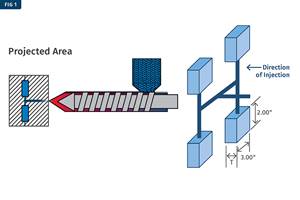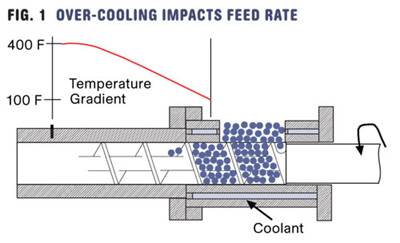Feed-Throat Temperature Control
It's the 'zone zero’ for injection molding.
It seems the “picky” details of injection molding never end … and this month we are picking on the feed throat. In the December 2010 issue, fellow columnist Jim Frankland ably covered the subject of “zone zero” as it applies to extrusion. Guess what? The same rules apply to injection molding—with a few added twists, naturally.
Getting the details locked in on the feed throat of your injection molding machines will provide a more robust process and make your life easier. Why? Because you’ll gain better feeding, shorter and more consistent screw rotation times, better melt uniformity, more consistent cycle times, and less splay or blush to boot.
First, let’s define the purpose of the feed throat:
1. It provides a clear, free-flowing path for plastic granules, powders, and liquids (such as liquid color) into the feed section of the screw.
2. It prevents the granules, etc. from sticking or clumping together (often called “bridging”) in the feed throat.
3. It provides a vent for volatiles, air, and off-gases as the polymer heats up. These gases are air, residual moisture, resin lubricants, and other additives that are volatile at the polymer’s melt temperature.
4. It connects to the feed zone of the barrel and screw without providing a condensation area for volatiles coming off the plastic and vented through the feed throat.
WHY BRIDGING?
Bridging in the feed throat is an aggravating problem that usually results in significant downtime. The normal tendency for molders faced with bridging is to lower the temperature of the feed throat, usually with water cooling. This makes logical sense, but to really solve the problem it helps to pinpoint the cause.
Back in the good old days, feed-throat bridging was usually the result of granules stuck together. We actually used to shove plastic rods in and out of the feed section to break up the clump and get things feeding smoothly again. Nowadays, bridging is almost always manifested in a completely frozen, fairly round ball of solid plastic that’s managed to wedge itself in the feed throat—a real chore to manually break apart and clear.
If this is what you face from time to time, you must wonder how this plastic ball formed and wound up in the feed throat in the first place. If you check the feed-throat temperature, my bet is that the temperature is far below the melting point of your resin. For example, most polypropylenes melt well above 230 F. So a feed throat set at 70 F to 150 F simply will not melt your polypropylene. But I’m getting ahead of myself.
To understand the formation of the ball of plastic in the feed throat we need to review a few aspects of screw design and melt theory. Assuming you use a so-called general-purpose screw with a 20:1 L/D, you have a screw with 10 flights of feed section, five flights of transition, and five flights of metering. Most of the 10 flights of feed can be seen by looking through the feed throat, and it is wise to check every now and then to see if there is any melted plastic in this section.
The feed section is not designed to melt the granules, just to auger them forward, so there should be no molten polymer or melted and refrozen polymer in these flights. Remember also that these deep feed flights are filled not only with plastic granules but with air, and lots of it. This air will get warm and needs to be vented through the hopper. Melted plastic in the feed zone prevents this from occurring.
WATCH FOR SPLAY
Such a blockage can also be a source of splay. If something is not set or working right, pressure can build and blow a hopper to the ceiling. Lots of plants have pock marks in the ceiling that prove this is no joke. As a safety measure, never look into the hopper or feed throat until you are sure there is no pressure, and always wear safety glasses or better yet, goggles. Blinding accidents have happened to the unwary.
If the feed throat does not melt the granules, and there is no melt in the feed section of the screw, then where does the melted plastic that freezes and forms the bridge come from? As I mentioned in this space last month, take a look at your non-return valve. These devices tend to leak so much that molten plastic is pushed all the way from the metering zone of the screw back up into the feed throat.
This happens during repeated injections followed by screw rotation, so melt gets pushed all the way back to the feed zone. Then, as the screw rotates, it pushes some of the molten plastic into the feed throat, where it cools and solidifies. Violà, the aforementioned plastic ball in the throat.
Next time you get a bridged feed throat, drill a hole in it (be careful not to scratch the feed throat), thread a screw into the hole, pull out the wad of plastic, and send me a picture. I bet you won’t see any individual granules in the bridge, indicating that it is composed of thoroughly melted material from the front of the screw.
HOW HOT A THROAT?
Now that we have explained the common cause of bridging, we need to go back to what temperature is best for the feed throat. The answer, of course, depends on the resin you are running, screw design, and perhaps shot size—especially with semi-crystalline resins. Such resins are more difficult to melt than amorphous ones; and as you build shot size, the plastic “sees” a shorter feed section of the screw, making the difficulty greater.
As a starting point, I recommend at least 130 F feed-throat temperature, unless you are dealing with a wax or some super-low-melting thermoplastic. From the point of view of venting (as noted above), warmer is better. If the polymer has to be dried, the feed zone could certainly be set 10° to 20° F lower than the drying temperature. A suitably warm feed zone prevents formation of a condensation ring, often a black tarry ring that is difficult to remove, at the junction of the feed section and the first zone.
Temperature control of the feed throat is critical. This zone should be kept quite warm—not at 70 to 110 F, but 130 to 250 F. What’s more, this zone is just as critical, perhaps even more so, than any other zone of the barrel or hot runner, so it should be PID controlled just like all your other barrel and hot-runner zones.
Related Content
Back to Basics on Mold Venting (Part 1)
Here’s what you need to know to improve the quality of your parts and to protect your molds.
Read MoreBack to Basics on Mold Venting (Part 2: Shape, Dimensions, Details)
Here’s how to get the most out of your stationary mold vents.
Read MoreIs There a More Accurate Means to Calculate Tonnage?
Molders have long used the projected area of the parts and runner to guesstimate how much tonnage is required to mold a part without flash, but there’s a more precise methodology.
Read MoreGot Streaks or Black Specs? Here’s How to Find and Fix Them
Determining the source of streaking or contamination in your molded parts is a critical step in perfecting your purging procedures ultimately saving you time and money.
Read MoreRead Next
People 4.0 – How to Get Buy-In from Your Staff for Industry 4.0 Systems
Implementing a production monitoring system as the foundation of a ‘smart factory’ is about integrating people with new technology as much as it is about integrating machines and computers. Here are tips from a company that has gone through the process.
Read MoreFor PLASTICS' CEO Seaholm, NPE to Shine Light on Sustainability Successes
With advocacy, communication and sustainability as three main pillars, Seaholm leads a trade association to NPE that ‘is more active today than we have ever been.’
Read More
.jpg;width=70;height=70;mode=crop)





















